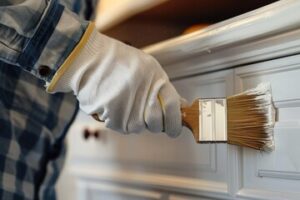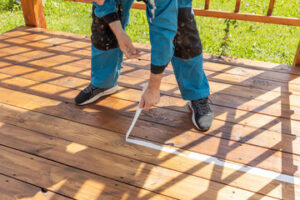Cabinet Painting Sacramento involves the preparation, priming, and painting of cabinet frames, doors, drawers, and hardware. Unlike other interior surfaces, cabinets require special preparation techniques like sanding and the use of durable products like degreasers and enamel paints.

Unlike latex options, enamels provide durability for wood surfaces and resist chipping or peeling over time. However, these materials take longer to dry and produce strong odors during application.
When painting cabinets, proper preparation is vital to ensuring that the paint adheres correctly and the finish looks professional. Cabinets are often painted over existing stain or paint, so this can lead to issues if the surface isn’t properly prepped. Incorrect or rushed prep work can also affect how long it takes to complete the project. Whether you are planning a DIY kitchen remodel or looking for someone to repaint your cabinets, the right steps can help you plan the project more effectively and ensure a beautiful result.
To begin, the cabinet surfaces should be cleaned thoroughly to remove any dirt or grease that may have built up over time. Then, they should be sanded to create an even texture before priming. This is especially important for doors and drawers, where a rough surface can collect paint that makes them hard to open and close. Using the correct grit of sandpaper and going over the entire cabinet will help to ensure that the upcoming layers of primer and paint adhere well.
Once the sanding is finished, any loose wood or laminate should be repaired with appropriate wood filler. Once the cabinet is ready for primer, a high-quality product should be used to ensure that it bonds with the existing surface material and prevents any bleed through from previous coats of paint. There are a wide variety of options available, so it is important to choose one that is specifically designed for cabinet use and dries quickly.
If you are painting over stained cabinets, it is recommended that two or more coats of primer be applied before the final coat of paint is applied. This will help to provide a thick and even base that will allow the new finish to last longer than it would without it. The type of finish you want will also influence how many coats of primer are needed.
Then, once the primer is dry, it’s time to start painting! Be sure to follow the underlying structure of the cabinet by starting at the rail and then working across the stile. This will help to prevent areas where the rail butts into the stile from being overpainted and ensure a smooth and even finish.
Primer
Cabinets and doors are often made of wood, and the grain patterns on these materials can show through standard latex paints, resulting in an uneven appearance. A heavy-bodied primer can help to fill in these grain patterns, creating a smooth surface for painting. It’s also important to sand any surfaces that will be painted, to create a “tooth” for the new paint to adhere to.
Once the sanding is complete, it’s important to wipe down the surfaces with a degreasing cleaner to remove any grease or oil that may still be on them. This will ensure that the new coat of paint will be able to stick properly and won’t peel or bubble in the future.
Primer is a crucial step in the process of painting cabinets, especially in moisture-prone areas like kitchens. It helps to prevent the paint from chipping or peeling in the future and evens out texture for a smooth, consistent finish. It also helps to hide stains, which is especially helpful if you’re going to be painting over a dark stain.
There are many different types of primers on the market, but the one we use for our projects is KILZ 3 Premium Primer, which has a high-hide formula and is available in a wide variety of colors. It’s low-VOC, which makes it ideal for indoor spaces, and it dries quickly so you can get on with the rest of your project!
If you’re transforming your cabinets from light to dark, it’s essential to use a good-quality Cabinets primer to achieve an even color. Without it, your new paint will look patchy and uneven, with the underlying stain showing through in patches. Using a good-quality primer is also key to ensuring that your new finish lasts as long as possible.
A good quality Cabinets primer is also mildew-resistant, which is an important feature for moisture-prone areas like bathrooms and kitchens. This prevents any unwanted mildew growth in the future and protects your new paint job from damage. Ultimately, investing in the right Cabinets primer is well worth it when you consider how much longer your paint job will last.
Paint
The type of paint you use for cabinet painting depends on the surface material, such as wood or laminate. Wood cabinets require oil-based paints such as alkyd enamel to provide a durable finish that can stand up to moisture and frequent cleaning. However, these paints tend to have more odors than latex options and may take longer to dry.
A more recent development is a hybrid formula often referred to as “acrylic-alkyd” that offers the easy clean-up and low odors of latex with the durability of oil-based finishes. These are typically recommended for cabinet painting and can be found at most hardware stores and home improvement centers.
Regardless of which type of paint you choose, high-quality paint is always a must. This will not only provide a more professional look, but it will also be easier to apply and will hold up better to wear and tear than cheaper alternatives.
It’s also a good idea to invest in a few quality brushes to make the job go more quickly and get a smoother, more professional finish. A flat brush in the 3- to 4-inch-wide range will help you cover large areas quickly and efficiently, while an angled paintbrush in the same size range can be used for corners and other difficult-to-reach spots.
If you’re painting over a stained surface, you will need to prepare the old color by lightly sanding and priming it before applying your new coat. If you’re working with a white or light-colored surface, on the other hand, you may be able to skip this step.
When choosing a color for your new cabinet paint, it’s important to consider how it will coordinate with the existing color scheme and other elements in your kitchen. While it may be tempting to try something completely different, this can often end up looking jarring and unmatched and will ultimately detract from the overall look of your room.
It’s usually a good idea to remove the cabinet doors before painting them, as this will prevent drips and other unsightly marks from marring your new paint job. If you plan on reinstalling the doors afterward, it’s a good idea to create a numbering system and mark each door and drawer front with its assigned number to ensure consistency during reassembly. It’s also a good idea to mask off the countertops, appliances and other areas that you don’t want to get paint on.
Finish
When the cabinets are dry and ready for re-adhesion, the final step is to apply the clear polyurethane topcoat. This protects the finish from damage, making cleaning easier, and extends its lifespan. It is important to use a high-quality water-based polyurethane that is designed for painted surfaces. Traditional oil-based polyurethane can yellow over time, and may not be ideal for a moisture-prone area like your kitchen. Choose a product such as **General Finishes High Performance Water-Based Polyurethane or **Minwax Helmsman Water-Based Polyurethane for best results.
Professional painters typically use specialized brushes and techniques to ensure precise results. They also have access to a variety of paint products, including cabinet enamels and latex paints that are specially formulated for a durable, hard-wearing finish. Choosing a cabinet paint with a low VOC (volatile organic compound) content is important for reducing indoor air pollution.
A paint sprayer is a great tool for applying the first coats of paint to cabinets. It allows for even coverage and eliminates roller texture and brush marks. It is a faster option for applying multiple layers of paint as well. A good quality hopper-style sprayer can be purchased for around $500, and will last for years.
After the first coat has dried, you can add a decorative glaze to your cabinet painting project for a more rustic or provincial look. Crackling glaze, available at most home improvement stores, can give your cabinets a weathered, shabby chic appearance.
If you want to change the hardware on your cabinets, this can be done at the same time as the painting process. The key is to label the hardware before removing it, and to be careful not to misplace any screws or bolts. You should place them in a plastic bag and mark the bag with where it goes on each cabinet door.
After the cabinets have been re-assembled, any gaps or holes can be caulked with wood filler. Any dents or dings should be lightly sanded before applying the new hardware, and all surfaces should be cleaned to remove any grease that has built up on the surface. The sanding will leave heavy dust behind, and it is important to vacuum or use a brush attachment on the hose of your shop vac to remove the dust before using a damp cloth to wipe down each piece. Once all surfaces are free of dirt and debris, they can be wiped down and prepped for the final steps of painting.
